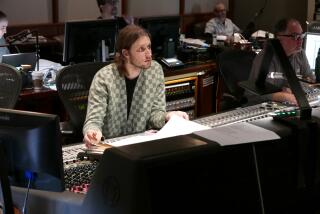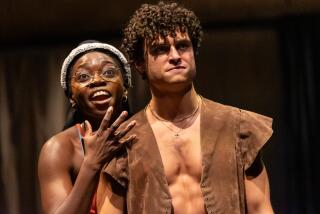Common Time : MEASURE FOR MEASURE: A Musical History of Science, <i> By Thomas Levenson (Simon & Schuster: $25; 351 pp.)</i>
- Share via
The history of measurement is, to some degree, a measure of human history. In the West, certainly, the search for meaning has been a cartographic survey, an attempt to map the dimensions of the place where we find ourselves. But as Thomas Levenson points out here, we desire to do more than simply register our coordinates; we desire to be sensually aware of the cosmic order.
A producer of that national treasure, WGBH’s NOVA, Levenson has written one previous meditation on science, “Ice Time” (1989), a study of climatology and its social implications. In the cleverly titled “Measure for Measure,” he shows how our historical yearning has led to the search for a novum organum-- a new instrument on which we might duplicate nature’s harmonies.
Levenson’s structure--in this work about the eternal pursuit of structures--is ingenious enough to demand recapitulation. He begins with the Pythagorean philosophers of ancient Greece, who in discovering “the oldest mathematically expressed law of nature” found surprising similarities between the musical and numerical scales. This led them to suggest a relationship between the macrocosm (represented by the first cosmological “theory of everything,” wherein planetary orbits sound a literal music of the spheres) and the microcosm (represented by the math of the overtone series).
The search for the ratios hiding in the overtone octave leads, in Levenson’s chronicle, to the development of the organ (from the Greek, for implement or instrument). Levenson weaves that invention’s social, political and intellectual consequences together into a story of the first rank. At one wonderful point, he casts the instrument as a 9th-Century Sputnik in the superpower contention between Byzantine and Carolingian fragments of the old Roman Empire:
“To possess an organ was to possess civilization. . . . The organ required sophistication to build, and it allowed is possessors to boast of their growing powers, symbolized by an instrument that could produce the marvelous roar of sound no unaided man could create.”
In Levenson’s reading, the birth of harmony brought by the medieval organ both represents and contributes to a growing restlessness with revealed knowledge: If music leads to a deeper understanding of God’s design, then more music--a more detailed elaboration of musical expression--might lead to a still greater apprehension of nature.
In short, Renaissance polyphony becomes the soundtrack that spurs on Renaissance polymorphous curiosity. Levenson traces the drift, born in infant universities, away from the parochial art of scholasticism toward the progressive science of measurement. Roger Bacon, with his love of gadgets and insistence on observation, serves as a transitional figure for the advance on empiricism. Refinements in optics, in turn, trigger the conceptual revolutions of Galileo and Van Leeuwenhoek.
Organ and microscope produce their Bach and Newton, twin figures of rational enlightenment, the high water marks of the attempt to formalize universal knowledge. The alchemist side of Newton affords an examination of the chemical still, the device that helped decant medieval nominalism, the notion that one can name the world, but never perceive its real existence.
The belief in a truth hiding in a particular shape of things evolves into the precursor of modern reductionist materialism, where truth is cornered by successive splitting and weighing. Applied chemistry bursts forth, born of a nervous marriage of theory and practice and epitomized by John Dalton’s intricate table of atomic weights, which was confirmed by measurements with the breathtakingly accurate “pan balance,” the simplest instrument studied here.
In a neat next move, Levenson uses the cello--the sextant behind Bach’s suites--to introduce those limits that doom the Newtonian dream of solving the complete cosmos’s differential equations. The incalculably complex wooden box ushers in a consideration of non-linear systems, a taunt at the “scientific failure to comprehend how one form of musical sound can be made out of the simple raw materials of wood, gut, glue, oil, gum, and air.” Three centuries of reductionism’s inability to reproduce the sound of the Stradivari level a critique of measurement, leaving the “raw material of experience, the world out there, inaccessible to direct encounters.”
Poincare’s study of three gravitationally interacting masses--which showed the unpredictability of non-linear motion--and Heisenberg’s familiar trope, the Uncertainty Principle, pounded the final nail into determinism’s coffin.
Science, at this twist in Levenson’s plot, gives up its attempt to resolve the world’s measure and resorts instead to inductive modeling. Levenson’s own model of this process is the “SCID-hu mouse,” genetically engineered to emulate parts of the human immune system. In an intriguing formulation, he calls the chimerical hybrid both a simulation and an instrument for examining nature in living vitro. The SCID-hu mouse illustrates the present state of scientific investigation, where symbolic, predictive formulations give way to probabilistic, black-box mock-ups.
Levenson’s final instrument, the sampling synthesizer, returns us to the old organ keyboard, now newly tempered. The MIDI sequencer, most recent in a series of musical automatons, “evokes . . . an instance of how science works, how we manage to impose a sense of order on the limitless range of our experience.”
Organ, scope, still, balance, cello, doctored mouse, synthesizer: this quadrivium of scientific instruments and trivium of musical ones thus suggest a continuous, narrative octave. From the Pre-Socratics to chaos theory, the flex and flinch of empiricism plays out its scale. We take our measure in the tools we measure with, and sing unto the source of sensation a new tune. As Italo Calvino puts it, “(M)an is an instrument the world employs to renew its own image constantly.”
Levenson concurs. Science, he says, is a performance, a construction, not the God’s-eye view it once hoped to become:
“(B)oth science and music . . . are ultimately aesthetic endeavors. . . . (B)oth tackle the same kind of task, resolving some image of human experience into an abstract form. . . . The feature of science that throughout its history has marked it off from the other arts is the particular rigor imposed on it by the original discovery that the universe obeys mathematical laws. But the erosion of the authority that such rigor once granted to science caused by the discovery of uncertainty has in our own time restored that discipline to its place among the arts, the human crafts of order and abstraction.”
This conclusion, to my mind, is too strong. That measurement is informed with aesthetic assumption, that scientific postulates are artifacts, does not exempt them from their peculiar accountability to external evaluation or render them (vibrating super-strings notwithstanding) the functional equivalent of song. Like the model-making Levenson describes, his story too partakes of the strength and weakness of all grandly synthetic narratives: the fact that analogical comparison obscures even as it reveals.
Yet throughout this philosophical excursion, large and small connections do emerge, prolific, bracing, and metaphorically resonant. Levenson’s attempt to bridge the cultures of music and science is needed and courageous. His leaping, connective intelligence draws on various and discrete sources, and the rare entropic perturbations in his data result more from errors in transcription than conception. Perhaps such a panoramic audition of the human spirit’s symphonic metamorphosis makes it inevitable that the score be tooled at places into too systematic, too programmatic a story. Much more of science’s musical history remains to be told, especially at the cognitive meta-level that joins these two pattern-searching activities into more than analogical counterpoint. But toward that end, this book is a haunting obbligato.
An instrument, at its roots, is a contrivance for equipping or ordering. “Measure for Measure” is itself an instance of the investigative machines it describes, a model of model-making, an organ of thought. For whatever our observations at last conclude about the measure in all things, our minds will demand to dance to the detected meter. Toward that concert, such a book is, in all senses, instrumental.
More to Read
The biggest entertainment stories
Get our big stories about Hollywood, film, television, music, arts, culture and more right in your inbox as soon as they publish.
You may occasionally receive promotional content from the Los Angeles Times.










